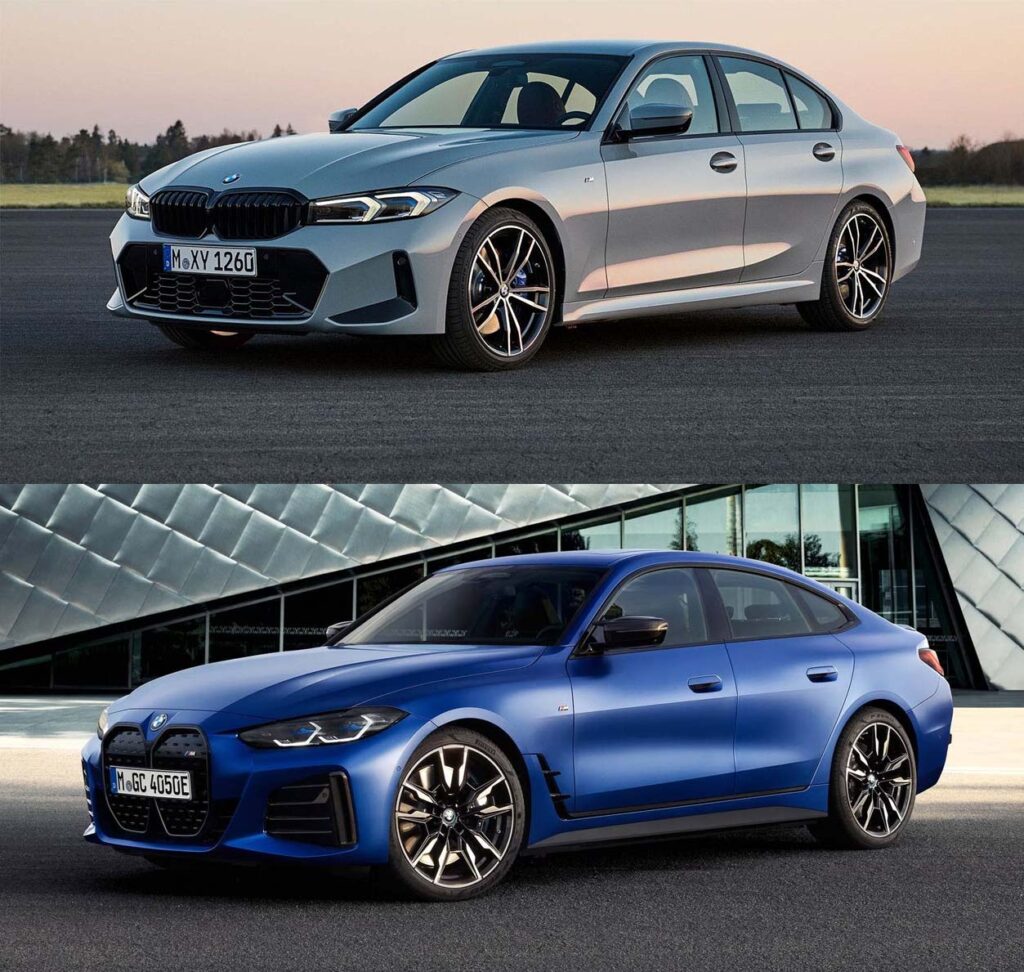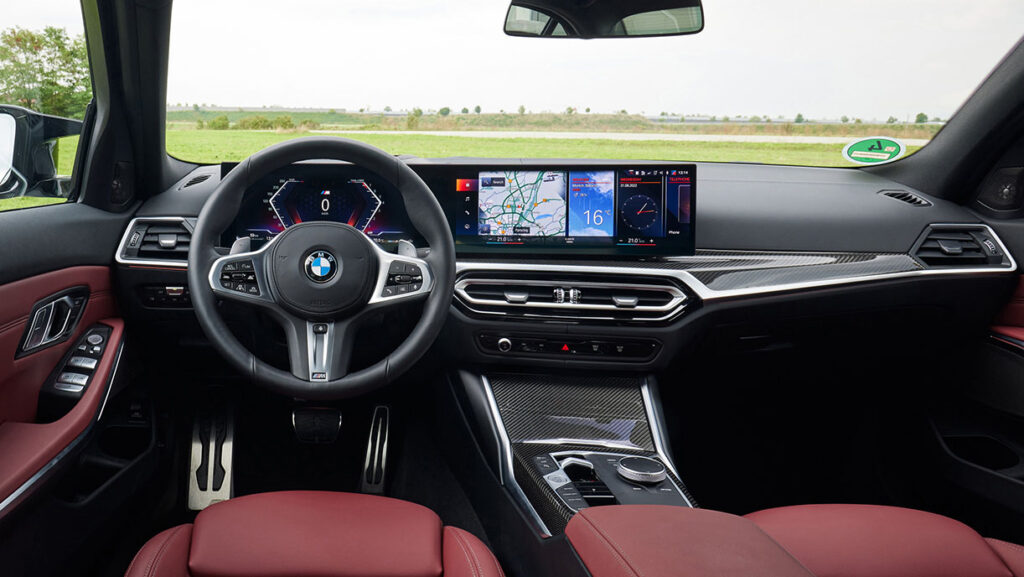The M340i represents the pinnacle of the G20 3 Series, boasting the outstanding B58 engine in an impressively responsive chassis.
On the other hand, the i4 M50 enters the lineup as BMW’s new performance-oriented, fully electric sedan.
How does the M340i stack up against the i4 M50? In this article, we’ll compare these two performance BMW sedans across a range of categories to help you decide which one is the right choice for you.
BMW M340i vs. BMW i4 M50 Overview

| M340i | i4 M50 | |
|---|---|---|
| Horsepower | 382 hp | 536 hp |
| Torque | 369 lb-ft | 586 lb-ft |
| Curb Weight | 3,968 lbs | 4,828 lbs |
| Dimensions (LxWxH) | 185.7″ x 71.9″ x 56.4″ | 185.9″ x 72.9″ x 57.0″ |
| Price | $54,850 MSRP | $67,300 MSRP |
| Range | 406 miles (gasoline) | 271 miles (electric) |
| Drivetrain | RWD or AWD (xDrive) | AWD (eDrive) |
M340i vs. i4 M50 Performance & Horsepower: B58 vs. Electric Drivetrain
While the M340i’s drivetrain is undeniably powerful and smooth due to the B58 engine being paired with the ZF 8HP transmission, the i4 M50’s electric drivetrain takes performance and smoothness to the next level.
The i4 M50 has a total output of 536 hp from its electric drivetrain and it outperforms a stock M340i, resulting in a more exhilarating driving experience.
The i4 M50 has considerably more horsepower and torque than the M340i
In terms of torque, the M340i can output 369 lb-ft while the electric motors of the i4 M50 output a peak torque of 586 lb-ft. Additionally, the electric drivetrain’s instant torque and responsive acceleration provide a different driving experience that is hard to match with a traditional internal combustion engine.
M340i vs. i4 M50 Handling & Driving Dynamics:
Both the M340i and i4 M50 have well-tuned firm suspensions. They both provide an engaging and responsive driving experience without sacrificing road isolation.
When pushed to the limits, the M340i has an advantage over the i4 M50. The lighter curb weight of the M340i makes it a more responsive car with more lateral grip. Hard cornering will exhibit much less understeer and the ~900 lbs of weight difference will be very noticeable when pushing the tires to the limit.
The xDrive M340i may start to understeer sooner than the RWD M340i, but both are still more nimble and capable of more grip than the i4 M50.
The M340i is a nimbler car with sharper handling, but it’s still heavy by any standard
Despite its considerable weight, the i4 M50 handles impressively well, thanks in part to its low center of gravity as the massive battery is located at the bottom of the chassis. Coming out of a corner with power is executed magnificently by the i4 M50 due to the precise power delivery of the all-wheel-drive electric drivetrain.
It’s important to note that both of these cars have a stiffer ride than non-M-Performance BMWs. If you prioritize comfort over handling capabilities, you might want to consider a 330i or an i4 eDrive40.
M340i vs. i4 M50 Exterior Looks: Performance Sedans with Style
The M340i and i4 M50 are both attractive sedans, with aggressive yet refined designs that are sure to turn the heads of every gearhead.
While both vehicles look stunning in the right color, we have a slight preference for the more traditional look of the M340i. The reasonable-sized kidney grill looks just right, and it’s reminiscent of the signature front look of BMWs.

The i4 M50 is one of the best-looking EVs to date, but we still prefer the looks of the M340i
The i4 M50 is one of the better-looking EVs out there, but it’s unfortunate that BMW decided to incorporate such a massive kidney grille in a car that doesn’t even need a front grille.
We do appreciate the streamlined look that resembles very closely a 4-Series Gran Coupe or a traditional sports sedan, instead of the bulbous look most EV manufacturers have opted for in their designs.
M340i vs. i4 M50 Drivetrain Options: RWD, xDrive, and Electric AWD
The M340i is available in both RWD and xDrive AWD configurations, paired exclusively with the fantastic ZF 8-speed automatic transmission. We recommend the rear-wheel drive variant of the M340i as it weighs less, and it’ll have a slight advantage when it comes to hard cornering.
In contrast, the i4 M50 comes only in an AWD configuration, with the electric drivetrain providing power to all four wheels. The AWD system of the i4 M50 is still rear-wheel biased, so despite it being an electric car BMW has tuned it to make it deliver power in a way that feels familiar to traditional gas-powered BMWs.
M340i vs. i4 M50 Tuning: Closing the Performance Gap
The performance gap between the M340i and i4 M50 can be narrowed through tuning. The M340i’s B58 engine is highly tunable, whereas the electric drivetrain of the i4 M50 cannot be tuned or modified for increased power, at least not yet.
A tuned M340i can be faster than the i4 M50. Installing a catless downpipe with its respective ECU tune can put the power of the M340i just slightly above 400 wheel horsepower while also increasing peak torque and broadening the torque curve.
While slower in stock form, the M340i can be upgraded to be more powerful than the i4 M50
If you’re looking to build a monster M340i you can also upgrade the turbo, introduce port injection, and run ethanol.
With the upgrades above, the M340i can surpass or rival the horsepower and torque numbers of the i4 M50.
Even with these mods, the M340i may not win from a standstill due to the tremendous torque available on tap from the electric motors of the i4 50, but will quickly catch up once the B58TU gets a chance to run at peak power RPMs.
M340i vs. i4 M50 Sound: Futuristic vs Traditional
The M340i’s aggressive and highly configurable exhaust system can make the right sounds when you want them. Although the B58 isn’t BMW’s best-sounding inline-6, a M340i in Sport+ mode with the exhaust valves open is an exhilarating audible experience for enthusiasts.
If you want even more sound coming out of the exhaust of your M340i, you can opt for an exhaust system upgrade. If you don’t care about exhaust sounds, you can keep it in Comfort mode and exhaust valves will remain closed for quiet acceleration.
The B58 in the M340i has a great exhaust sound. The driving sounds of the i4 M50 are also brilliantly executed.
On the other hand, the i4 M50 features Hans Zimmer-composed driving sounds. Fake spaceship-like sounds being pumped out from the speakers doesn’t sound like a fun time to an enthusiast, but we can say that the sounds are pleasant to hear and actually add to the driving experience.
However, for die-hard petrolheads, there is no substitute for the rich, satisfying engine note of the B58 in the M340i. We do appreciate BMW
M340i vs. i4 M50 Interior: Modern Comfort and Technology
Both the M340i and i4 M50 feature nearly identical interiors, complete with the latest iDrive 8 infotainment systems, high-quality materials, and a blend of luxury and sportiness.
The i4 M50, however, benefits from the additional space provided by its electric platform, offering slightly more rear legroom and a more spacious feel overall.

In terms of technology, both vehicles are equipped with advanced driver assistance systems, but the i4 M50’s electric architecture provides additional features, such as regenerative braking and unique EV-specific settings.
M340i vs. i4 M50 Range & Charging: Gas vs. Electric
A 2023 M340i has an EPA-rated range of 406 miles while the 2023 i4 M50 has an EPA-rated range of 271 miles. As expected, the gasoline-powered car can go further without refueling or recharging.
The M340i’s gasoline engine provides the flexibility and convenience of the wide network of gas stations and quick refueling times. All the M340i needs is 91 Octane (AKI) gasoline.
The M340i is more convenient for long trips while the i4 M50 is excellent for city driving and commuting
While charging times vary based on the charging station’s power output, the i4 M50 supports up to 200 kW fast charging, allowing for an 80% charge in around 30 minutes.
The electric vehicle infrastructure continues to grow, but for those frequently driving long distances or in remote areas, the M340i’s gasoline engine is more convenient.
Efficiency:
The i4 M50 clearly takes the lead in terms of efficiency, as it is a fully electric vehicle with an estimated 96 eMPG.
The M340i, on the other hand, relies on its efficient B58 engine paired with the ZF8 to achieve a combined 26 MPG. For those seeking a more eco-friendly option, the i4 M50 is the obvious choice.
M340i vs. i4 M50 Price & Value: Luxury & Performance at a Cost
Both the M340i and i4 M50 carry premium price tags, reflecting their luxury performance sedan nature. The M340i starts at around $54,850, while the i4 M50 comes in at approximately $67,300. Not a bargain at all, but an excellent proposition if we consider the performance you get.
The i4 M50 may qualify for federal and state EV incentives, which could narrow the price gap between the two models.
Conclusion: Performance Meets the Future
The BMW M340i and i4 M50 represent two distinct approaches to the performance sedan: one rooted in BMW tradition and equipped with one of the best internal combustion engines. The other one embraces an electrified future.
The M340i’s B58 engine, engaging handling, and classic styling make it an excellent choice for those seeking a traditional BMW driving experience.
The i4 M50, on the other hand, offers groundbreaking electric performance, futuristic design, and cost savings in the long run.
Both vehicles are fantastic choices in their own right. As petrolheads, we would pick the M340i due to the sound and tuning potential, but the i4 M50 is an impressive vehicle as well.

